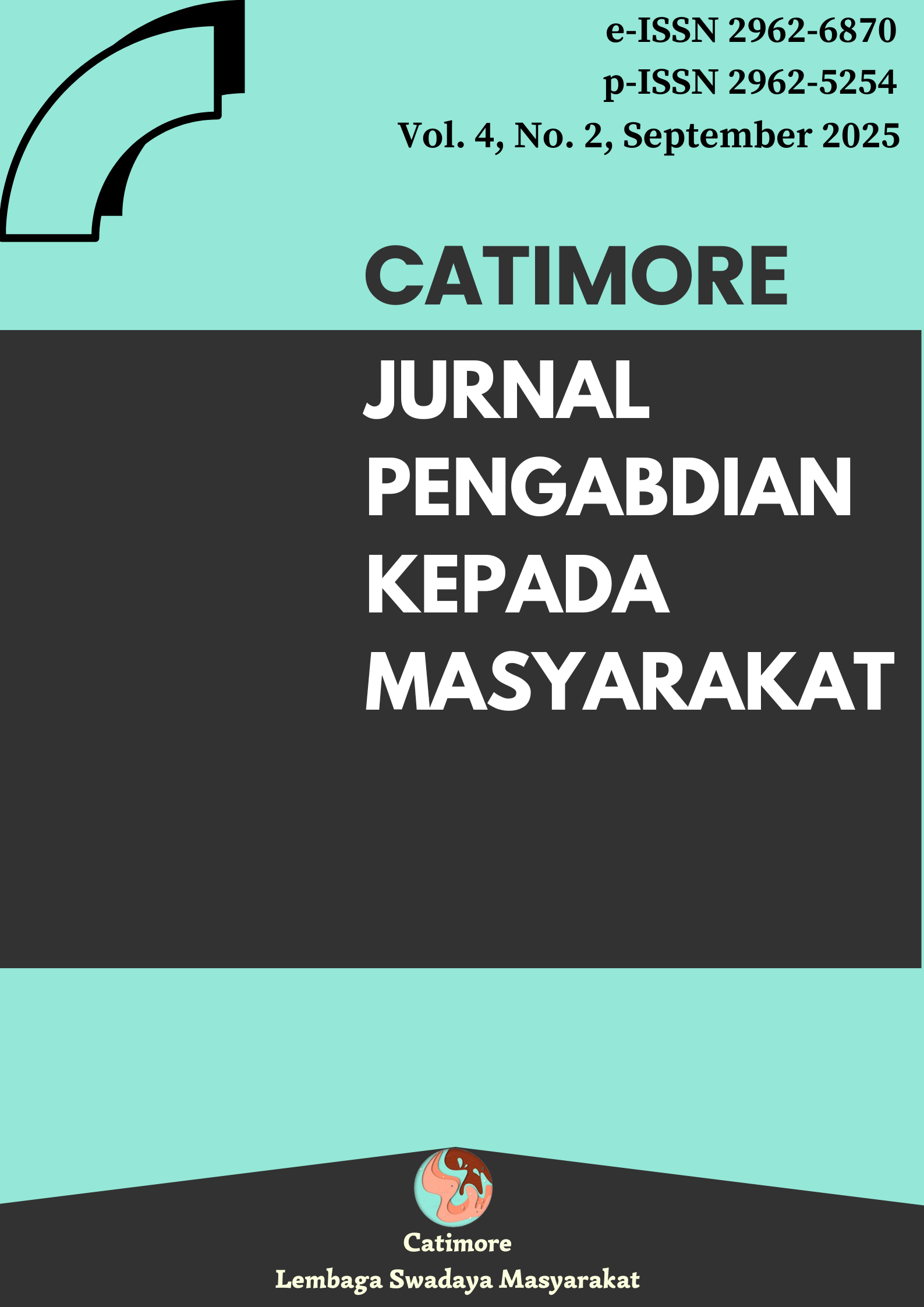Integrasi Kurikulum Literasi Digital pada Sekolah Alam: Generasi Alpha Tanggap Cyberbulliying dalam Penggunaan Teknologi
DOI:
https://doi.org/10.56921/cpkm.v4i2.325Keywords:
Literasi digital, Cyberbullying, Integrasi kurikulumAbstract
Digital gadgets are now common in elementary schools, offering many benefits for learning. However, they also bring new problems, with cyberbullying being a serious risk for young children. This project aimed to teach students at Sekolah Alam Bireuen about cyberbullying—what it is, how it hurts people, and how to stop it. We worked with 20 students in grades 5 and 6. Using hands-on activities like discussions and role-playing, we helped them understand the different roles in a cyberbullying situation: the target, the person doing the bullying, and the witnesses. The students showed a strong increase in their understanding and pledged to be "Digital Heroes" who use technology kindly and responsibly. This work shows that directly teaching children about online safety is a necessary and effective part of modern education.
References
Adawiah, R. Al, & Eleanora, F. N. (2023). Perundungan Dunia Maya pada Anak: Tinjauan Fenomena dan Tren dalam Rentang 2016–2020. Aspirasi: Jurnal Masalah-Masalah Sosial, 14(1). https://doi.org/10.46807/aspirasi.v14i1.3065
Afif, N., Mukhtarom, A., Nur Qowim, A., & Fauziah, E. (2024). Pendidikan Karakter Dalam Era Digital: Pengintegrasian Nilai-Nilai Moral Dalam Kurikulum Berbasis Teknologi. Tadarus Tarbawy, 6(1), 18–32.
Arifin, M. B. U., & Marnah. (2023). Intensity Analysis of Gadget Use on Learning Disciplines of Elementary School Age Children. Didaktika: Jurnal Pendidikan Sekolah Dasar, 6(2), 133–144.
Bibizadeh, R. E., Procter, R., Girvan, C., Webb, H., & Jirotka, M. (2025). Digitally Un/Free: the everyday impact of social media on the lives of young people. Learning, Media and Technology, 50(2), 205–218. https://doi.org/10.1080/17439884.2023.2237883
Contrino, M. F., Reyes-Millán, M., Vázquez-Villegas, P., & Membrillo-Hernández, J. (2024). Using an adaptive learning tool to improve student performance and satisfaction in online and face-to-face education for a more personalized approach. Smart Learning Environments, 11(1), 1–24. https://doi.org/10.1186/S40561-024-00292-Y/FIGURES/7
Dontre, A. J. (2021). The influence of technology on academic distraction: A review. Human Behavior and Emerging Technologies, 3(3), 379–390. https://doi.org/10.1002/HBE2.229
Gohal, G., Alqassim, A., Eltyeb, E., Rayyani, A., Hakami, B., Al Faqih, A., Hakami, A., Qadri, A., & Mahfouz, M. (2023). Prevalence and related risks of cyberbullying and its effects on adolescent. BMC Psychiatry, 23(1), 1–10. https://doi.org/10.1186/S12888-023-04542-0/TABLES/5
Macaulay, P. J. R., Betts, L. R., Stiller, J., & Kellezi, B. (2022). Bystander responses to cyberbullying: The role of perceived severity, publicity, anonymity, type of cyberbullying, and victim response. Computers in Human Behavior, 131. https://doi.org/10.1016/J.CHB.2022.107238
Maurya, C., Muhammad, T., Dhillon, P., & Maurya, P. (2022). The effects of cyberbullying victimization on depression and suicidal ideation among adolescents and young adults: a three year cohort study from India. BMC Psychiatry, 22(1), 1–14. https://doi.org/10.1186/S12888-022-04238-X/TABLES/4
Mrug, S., Madan, A., & Windle, M. (2016). Emotional Desensitization to Violence Contributes to Adolescents’ Violent Behavior. Journal of Abnormal Child Psychology, 44(1), 75–86. https://doi.org/10.1007/S10802-015-9986-X/METRICS
Muppalla, S. K., Vuppalapati, S., Pulliahgaru, A. R., & Sreenivasulu, H. (2023). Effects of Excessive Screen Time on Child Development: An Updated Review and Strategies for Management. Cureus, 15(6). https://doi.org/10.7759/CUREUS.40608
Peng, H., Ma, S., & Spector, J. M. (2019). Personalized adaptive learning: an emerging pedagogical approach enabled by a smart learning environment. Smart Learning Environments 2019 6:1, 6(1), 1–14. https://doi.org/10.1186/S40561-019-0089-Y
Perkasa, S. (2025, August 7). Tak Cuma Roblox, Ini Daftar Game ’Terlarang’ di Indonesia. Metrotvnews. https://www.metrotvnews.com/read/KYVC4q7j-tak-cuma-roblox-ini-daftar-game-terlarang-di-indonesia
Reswari, P. A. D., & Susiana, S. (2025). Pelindungan Anak dari Ancaman Kekerasan Di Dunia Digital. https://berkas.dpr.go.id/pusaka/files/info_singkat/Info Singkat-XVII-4-II-P3DI-Februari-2025-2480.pdf
Tarabah, A., Badr, L. K., Usta, J., & Doyle, J. (2016). Exposure to Violence and Children’s Desensitization Attitudes in Lebanon. Journal of Interpersonal Violence, 31(18), 3017–3038. https://doi.org/10.1177/0886260515584337;Subpage:String:Abstract;Website:Website:Sage;Wgroup:String:Publication
Warschauer, M., & Xu, Y. (2018). Technology and Equity in Education. In J. Voogt (Ed.), Second Handbook of Information Technology in Primary and Secondary Education (1st ed., pp. 1–17). Springer Cham. https://doi.org/10.1007/978-3-319-53803-7_76-1
Wright, M. F. (2023). Adolescent Cyberbullies’ Attributions: Longitudinal Linkages to Cyberbullying Perpetration. International Journal of Environmental Research and Public Health, 20(12). https://doi.org/10.3390/IJERPH20126083
Zhu, C., Huang, S., Evans, R., & Zhang, W. (2021). Cyberbullying Among Adolescents and Children: A Comprehensive Review of the Global Situation, Risk Factors, and Preventive Measures. Frontiers in Public Health, 9. https://doi.org/10.3389/FPUBH.2021.634909/BIBTEX
Downloads
Published
How to Cite
Issue
Section
License
Copyright (c) 2025 Rahima Nurviani, Nurasiah Nurasiah, Luh Ayu Auranisa, Rahmy Zulmaulida

This work is licensed under a Creative Commons Attribution-ShareAlike 4.0 International License.















